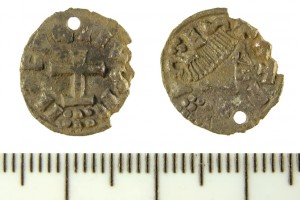The Treasure Act 1996 can be difficult to interpret with respect to certain specific classes of objects, one of which is pierced coins. That is because under the Act there are two sets of rules that are applied to artefacts and determine whether they are counted as ‘Treasure’. One set of rules applies to coins, another to all other worked objects. What about something that can appear to fit both definitions?
Under the Treasure Act, single precious metal coins are not considered to be Treasure, but single precious metal coins that have been modified into objects – that is, altered in some way as to make it likely that they were taken out of circulation – can, if older than 300 years old, qualify as Treasure.
This is usually seen in the form of a conversion of the coin into a brooch or pendant, or some other form of jewellery or dress accessory, evidence of which can include the addition of a suspension loop to the top, a pin (or the remains of one) at the back, or gilding. Additionally, the coin can be pierced in one or more places.
In consultation with the relevant British Museum curators and with the National Finds advisors, it was clear that in some cases, depending on the age and type of coin and the position of the piercing, a piercing by itself could constitute sufficient evidence of modification, and that it would qualify as Treasure.
This is most likely to be the case in the Early Medieval period, up to the date of 1180AD. Most known examples of pierced coins from this period are believed to have been removed from circulation. Consequently, if a pierced precious metal coin of this period is discovered, it should be reported as potential Treasure.
In the past, examples of pierced Iron Age and Roman coins have not been put through as Treasure; however, a gold or silver pierced coin from either of these periods may constitute Treasure, depending particularly on the location of the piercing, and may need to be reported; please show it to your nearest Finds Liaison Officer, who can liaise with the appropriate curator/finds advisor if necessary and get back with further guidance.
After 1180AD, examples of pierced coins appearing amongst other coins in hoards are known, and it is in this period where we are likely to need other features on the coin to convincingly argue that it was modified into an object. However, piercings along the edge, at the top or bottom of the coin (with respect to either obverse or reverse, or in such a way that any cross on the reverse would be upright) may indicate modification and removal from circulation. So, if a precious metal coin of this date pierced in the manner described above is found, it may constitute Treasure and may need to be reported; contact your local Finds Liaison Officer for their advice. If necessary, they can liaise with the appropriate curator/finds advisor and provide further guidance.
Please be aware that corrosion or physical damage to a coin may be sufficient to produce a hole. If it is clear that the hole is a result of factors such as these, and not intentional modification, it will not be eligible to be Treasure.
As always, if there is any question over whether an item may qualify as Treasure, we would urge a finder to contact their local Finds Liaison Officer.

Anglo-Saxon silver pierced denier from Suffolk declared Treasure and in the process of being acquired by Colchester and Ipswich Museums Service